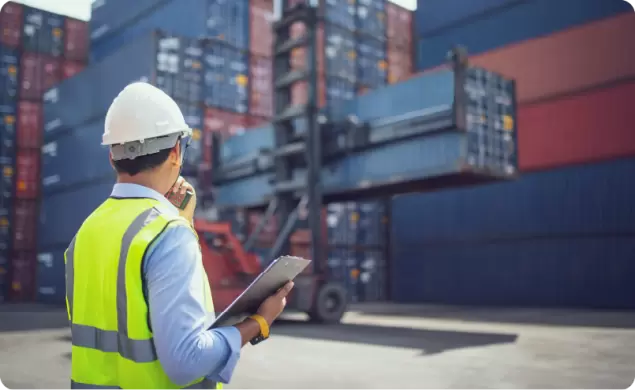Declaration system NCTS will be replaced by DVA in the Netherlands.
- Tue, May 21, 2024
- 4.5 minute read

What is changing?
The changes are mainly software-related. In DVA, for instance, the message structure will change and declarations will have more layers. The ‘transport’ process will not change. Existing licences ‘Authorised consignor’ and ‘Authorised consignee’ will remain valid.
More layers in the declaration
Declarations in NCTS have two layers: declaration and item level. In DVA, declarations will consist of four layers:
- The ‘envelope’: This is a selection of data elements that are also included in other layers in the declaration.
- Master consignment: The master consignment contains general information about the whole declaration, related to the transport contract. This includes details such as the location of the goods, the licence number and all parties involved.
- House consignment: At this level, additional information is required on the parties involved in the consignment. All persons involved in the consignment must be included in the declaration. This allows Customs to get a complete picture of all parties involved in the transport process.
- Item level: At this level, details about the goods to be transported are recorded. Not many changes have been made compared to the NCTS system. However, it is now mandatory to include a six-digit commodity code in the declaration.
For container transport through DVA, it is no longer necessary to include the registration number or the name and nationality of the vessel or vehicle in the transit declaration in addition to the container number. This is because the container number remains the same even if the modality changes (e.g. from vessel to truck). In case of transport other than container transport, stating the identity and nationality of the original and new vessel or vehicle remains mandatory.
New office roles
Besides the new layers in the declaration, two new office roles have also been introduced: the ‘office of incident’ and the ‘office of exit on export’.
Office of incident
If an incident occurs during transport, such as the breaking of a seal, it must be reported to the nearest customs office. This may be a different office from the office of destination and is then called the office of incident.
Office of exit on export
This covers security data in the declaration and leaving the security area: EU, Switzerland and Norway. When leaving this area, data will be exchanged between the transit system and the export system. This requires the inclusion of security data in the declaration and the lodging of a combined declaration (the declaration must be combined with a summary declaration). If no security data is lodged (i.e. no combined declaration is made), a summary declaration will have to be lodged at the last office of the security territory, so that this data can still be completed.
In the background, messages will be exchanged with AES to check that these two declarations are identical. Linking with AES creates the new office role: office of exit in transport. In doing so, Customs will send the following messages:
- Is the declaration linked to AES and have any changes been made to the declaration? Then customs sends the message ‘Notification for change of declaration’ (IE022).
- Is a declaration rejected at the office of departure based on a functional error (not a technical error)? Then a rejection message (IE056, previously an IE016) is sent.
- Is a declaration rejected at the office of destination based on a functional error? Then the ‘Rejected by office of destination’ message (IE057, formerly IE008 or IE058) is sent.
- Does Customs want to check the consignment at the office of departure? Then the message ‘Control notification’ IE060 (is unchanged) is sent.
- Does Customs want to check the consignment at the office of destination? Then the message ‘Notification control office of destination’ (IE061) is sent. This message is new and applies only to ‘Authorised consignees’.
Other changes
In addition to the aforementioned changes, the following will also change:
- The abbreviation MRN no longer stands for ‘Movement Reference Number’, but for ‘Master Reference Number’;
- In addition, the call segment lump sum disappears. In NCTS, lump sums can be specified as security when the invoice amount is unknown. With the introduction of DVA, this is no longer possible.
- The Transit Accompanying Document (TAD), has now been replaced by a new model because the old model no longer complies with current legislation. There is one model, TAD, which replaces both the old TAD and TSAD.
- The accompanying document no longer needs to be printed out, however, the MRN number must be shown at any time when requested by customs.
- Planned transhipment of a container (e.g. from truck to barge) is no longer an incident during transport but a regular process. Authorisation is no longer required.
Transition and deployment timeline
After 1 December 2024, NCTS will be closed and declarations can only be made in DVA. The timeline is as follows:
- In early 2024, Dutch Customs will provide completion instructions to declarants.
- In March 2024, the test environment BTO will open for companies.
- Due to a changed strategy, DVA will not go into production on 1 July 2024, but will most likely take place in quarter 4. From then on, companies can connect to DVA.
- From 1 October 2024, all companies must be connected to DVA.
- NCTS will be discontinued after 1 December 2024.
What does this mean for you as a customer?
Because declarations in DVA consist of multiple layers at the item level, more data may be required regarding the goods and carriers. It is therefore important to ensure you are able to provide this data. In addition, a six-digit HS code should be provided.
Important: Penalty policy for transit
In early February, Dutch Customs introduced a penalty policy for transit. This means that penalties have since been imposed on companies that fail to comply sufficiently with the rules. The penalty policy applies to transit declarations released on 1 January 2024 or later. Every declaration that results in a customs debt and a payment invitation will be subject to a penalty imposed by Customs.
To avoid fines, you need to comply with the rules: submit declarations correctly and completely and ensure clearance of T-documents within the validity period. Should a document still end up in the so-called enquiry procedure, make sure it is followed up to avoid a UTB and a fine.
Do you have any further questions about the transition from NCTS to DVA?
If you have further questions about the transition from NCTS to DVA, you can contact our customs experts. Complete the form on the right and a member of our team will respond within one business day.




